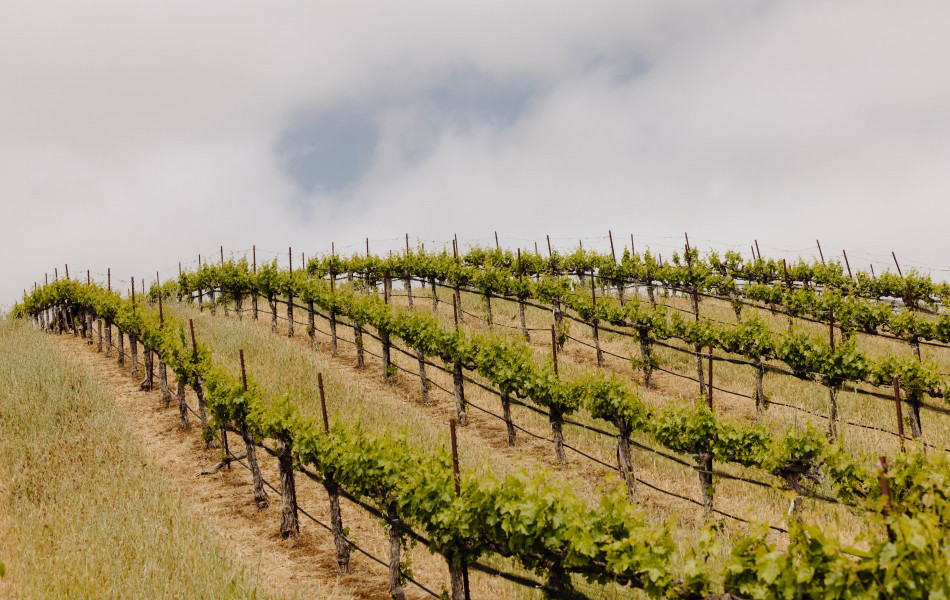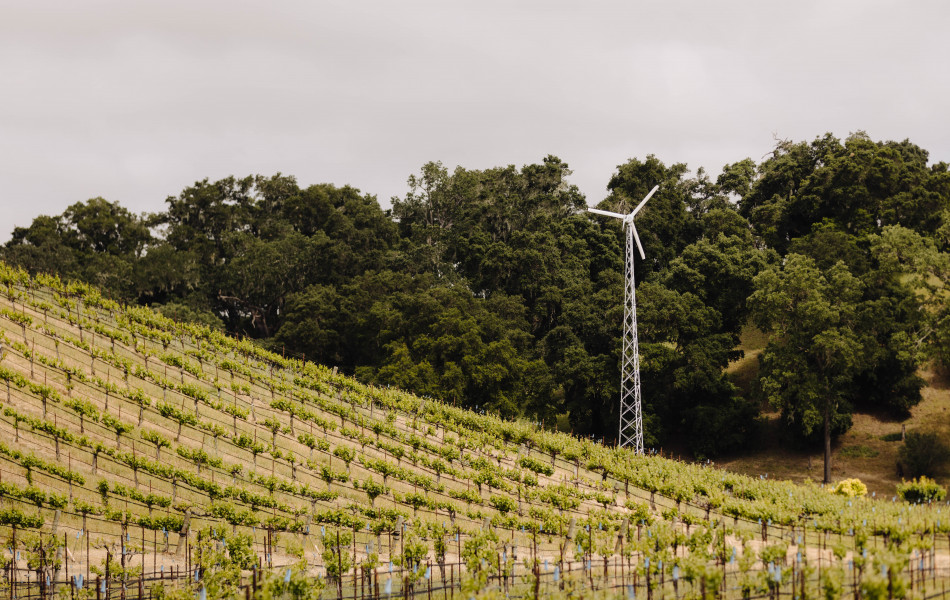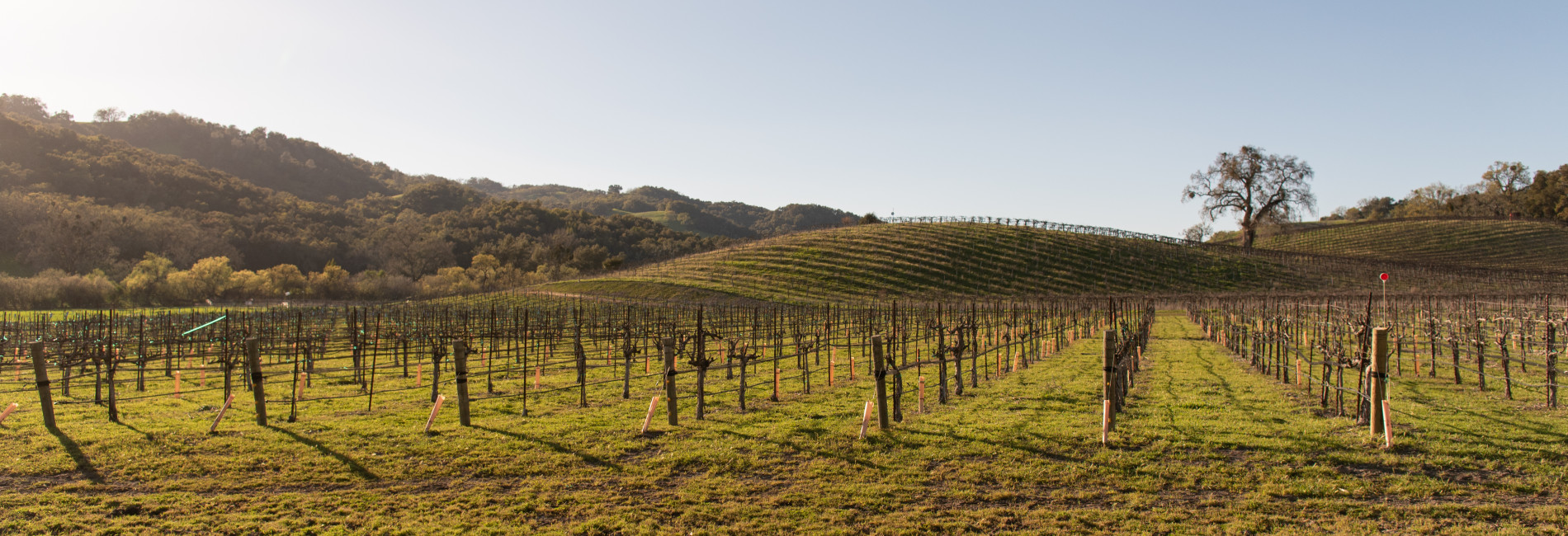Terroir
Our 15 acre vineyard is planted with Cabernet Sauvignon, Primitivo, and Mourvèdre.
Our unique combination of geology, geography, and climate in the Adelaida District of Paso Robles provide us with a terroir that is highly sought after in viticulture.

Our Soils
The soils on our ranch are diverse and the grapes were planted to take the best advantage of the site condition of each block. Much of our Primitivo and Cabernet Sauvignon is planted on a steep hillside of Linne-Calodo soil type #152. This calcareous limestone soil is especially well suited for growing robust grapes and is very desirable. The grapes struggle to root and thrive in this soil, but produce exceptional fruit because of the adverse conditions.
We selected specific grapevine clones and American rootstocks that are best suited to our local micro-climate and geology. We use the 1103 PAULSEN American rootstock specifically for its resistance to pests and preference for drought-prone soils and hillsides. These roots adapt well to clay/lime soils and put up with our wet winters. All of these attributes match the conditions on the property and allow us to get the best performance from the grape vines while maintaining our sustainable farming program. The vineyards are widely spaced on a 10 by 6 foot vertical trellis system. We designed the system to minimize erosion, receive abundant sunshine, absorb vital mineral nutrients, and allow for ease of management, all in the goal of sustainability.
Our pruning, leaf pulling, fruit thinning and harvest practices give us the best defense against our number one potential enemy: adverse weather which quite often includes unseasonable rain, wind and freezing temperatures. We have a frost protection wind-generating machine combined with our sophisticated micro-sprinkler system. We engage both systems just prior to harvest (usually October or November) or during bud break (usually March or April) if the temperatures drop near or below freezing.
Our Mourvèdre is planted in the lowest parts of our property. We call it our blessed (Bendicion) grapes because we fight early and late frost every year. Most years our harvest from these vines yield small quantities but spectacular fruit and produce only one to two tons per acre. Planted entirely in soil type #132, the Mourvèdre is deeply rooted in sedimentary alluvium of calcareous clay.
Our lower hillsides are dominated by gently sloping alluvium composed primarily of soil type #188, which is a Rincon clay loam. This is a very good soil for producing high quality grapes allowing for deep rooting.
We are small so our vines get a lot of attention, as we are hands on with every aspect of our intensive vineyard management system. In accordance with our sustainable farming policies, we have incorporated our livestock program for weed and nutrient management. Also the vineyard is planted with a cover crop of nitrogen yielding clovers and native grasses, which allows us to reduce erosion, return beneficial nutrients to our vines and greatly reduce our use of herbicides, pesticides and tractors.

Our Vines
We use an American grapevine rootstock specifically selected for its resistance to pests and preference for drought prone soils and hillsides. These roots adapt well to our clay/lime soils and tolerate our wet winters. Oso Libre’s sustainably farmed vineyards are deeply rooted in rugged calcareous (limestone) soils exposed to sunshine and ocean influenced air consistently bearing complex fruit. Our location in the cooler West side Adelaida region of the Paso Robles AVA, is only 10 miles from the coast, and is highly desirable for its unique micro-climate. This micro-climate coupled with our selective vineyard management allows our estate yield to be intentionally very low.
Harvest season at Oso Libre occurs in late October or early November. This provides an extended hang time for the grapes, which is about four to six weeks longer than in warmer climates. The longer time on the vine allows for more intense flavors, color, complexity and true varietal characteristics to develop. The combination of all these features permits us to achieve the best performance from our grape vines while preserving our commitment to our sustainable farming program. The end result is the highest quality grapes bearing delicious flavors and proper balance, which is essential for great wine.
Varietals
Cabernet Sauvignon
Cabernet Sauvignon became internationally recognized through its prominence in Bordeaux wines. From France, the grape spread across Europe and to the New World where it found new homes in places like Paso Robes. For many years, the origin of Cabernet Sauvignon was not clearly understood and many myths and conjunctures surrounded it. The word "Sauvignon" is believed to be derived from the French sauvage meaning "wild" and to refer to the grape being a wild Vitis vinifera (Wine Grape) vine native to France. Until recently the grape was rumored to have ancient origins, perhaps even being the Biturica grape used to make ancient Roman wine and referenced by Pliny the Elder.
The grape's true origins were discovered in the late 1990s with the use of DNA typing at the UC Davis. The DNA evidence determined that Cabernet Sauvignon was the offspring of Cabernet franc and Sauvignon Blanc and was most likely a chance crossing that occurred in the 17th century.
Its popularity is often attributed to its ease of cultivation. The grapes have thick skins and the vines are hardy and resistant to rot and frost. Its consistent presentation of structure and flavors express the typical character ("typicity") of the variety.
Our Cabernet Sauvignon is the certified clone FPS 08 and is one of three selections at FPS (Foundation Plant Services at UC Davis) taken from the same single vine source: Concannon R34 v2. FPS 08 first appeared on the list of registered vines in 1971. FPS 08 was characterized by Dr. Jim Wolpert (UC Davis) as a "high yielding, late-maturing" selection in the 1995 ASEV Proceedings of the International Symposium on Clonal Selection.
Mourvèdre
Mourvèdre, as wine historians suspect, may be a variety of ancient origin, perhaps introduced to the Barcelona area of Spain by the Phoenicians in 500 BC. The name Mourvèdre is derived from the town of Murviedro in Valencia, and the name of Mataró is derived from the town of Mataró in Catalonia. After the sixteenth century, the variety was brought to France. The grape is thought to have arrived in California in the 1860s.
Our Mourvèdre at Oso Libre is planted with the ENTAV-INRA ® 369 authorized clone from ENTAV in France. The French National Technical Association for Viticultural Improvement certifies this clone for its authenticity and quality. Clones with this certification are among the highest quality producing grapes in the world.
Primitivo
The first documented use of the term Primitivo appears in Italian governmental publications in the 1870s. This name's appearance, 40 years after the first documented use of the term Zinfandel, was previously thought to suggest that Primitivo was introduced to Italy from across the Atlantic. However, this hypothesis became unlikely since the discovery of the vine's Croatian origin. Primitivo is now thought to have been introduced as a distinct clone into the Apulia region of Italy in the 18th century. In 1993, a DNA fingerprinting technique was used to confirm that Primitivo and Zinfandel are clones of the same variety. Comparative field trials have found that Primitivo selections were generally superior to those of Zinfandel, having earlier fruit maturity, similar or higher yields, and similar or lower bunch rot susceptibility. This is consistent with the theory that Primitivo was selected as an early-ripening clone of a Croatian grape. Certain California regions are regarded as "exceptional" for Zinfandel, each with identifiable flavor characteristics.
Fortunately, San Luis Obispo, particularly our Paso Robles AVA is listed as one of those exceptional regions. Due to our hot days and cool maritime evenings, our Primitivo/Zinfandel is known for having a good sense of body that is not overly tannic. Zinfandel is often praised for its ability to reflect both its terroir and its winemaker's style and skill. We use the low annual yields from our Estate Primitivo Vines in many creative ways. We make an Estate Varietal called Nativo and we also use our Primitivo as a blender to add spice, body and interest to many other wines. Look for it in our Rojo del Patron, Por Vida, and Primoroso.
Viognier
Viognier is from Southern France, in the Rhône Valley districts of Condrieu and Château-Grillet. Some people believe that the vine originally was brought to France by the Roman Emperor Probus from the Dalmatia region where it is now cultivated under the name Vugava bijela. The areas now planted to Viognier are increasing worldwide.
Our Viognier at Oso Libre is planted with the ENTAV-INRA ® 642 authorized clone from ENTAV in France. The French National Technical Association for Viticultural Improvement certifies this clone for its authenticity and quality for. Clones with this certification are among the highest quality producing grapes in the world.

